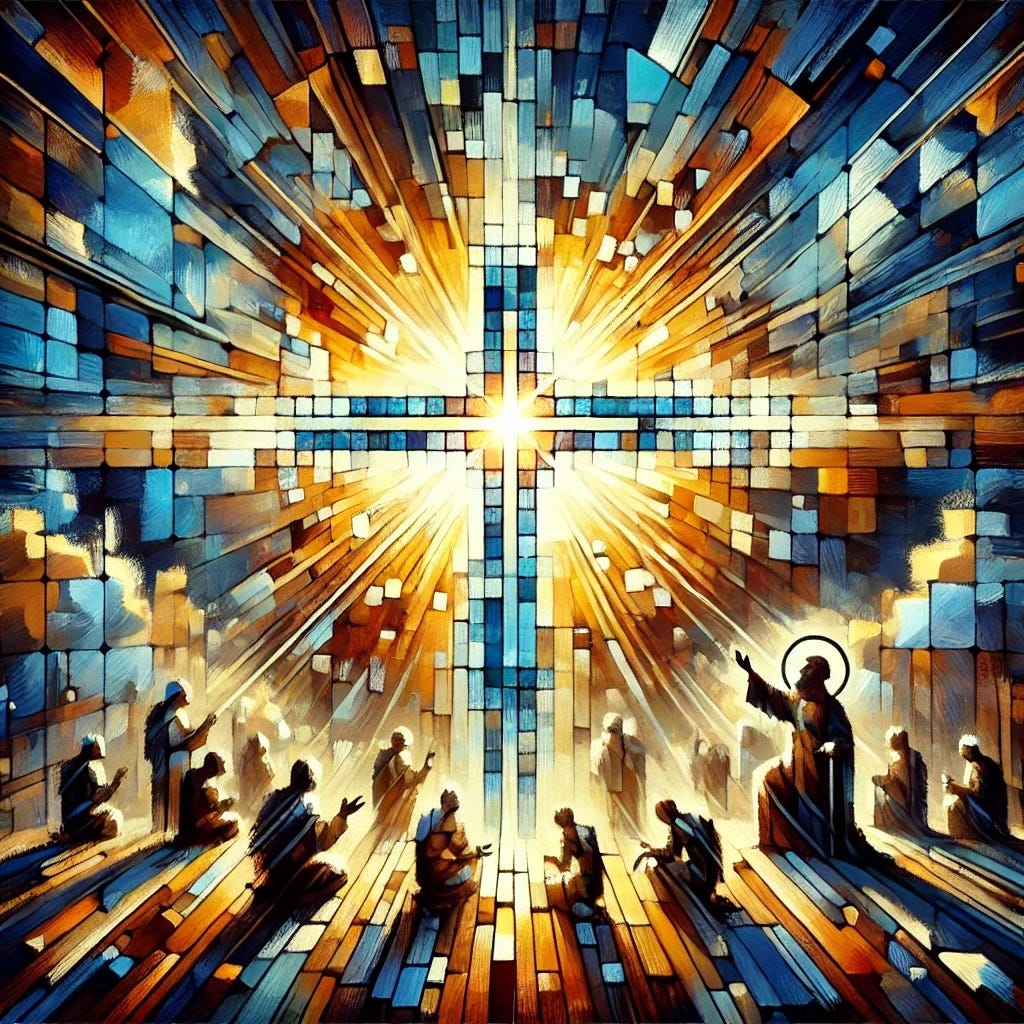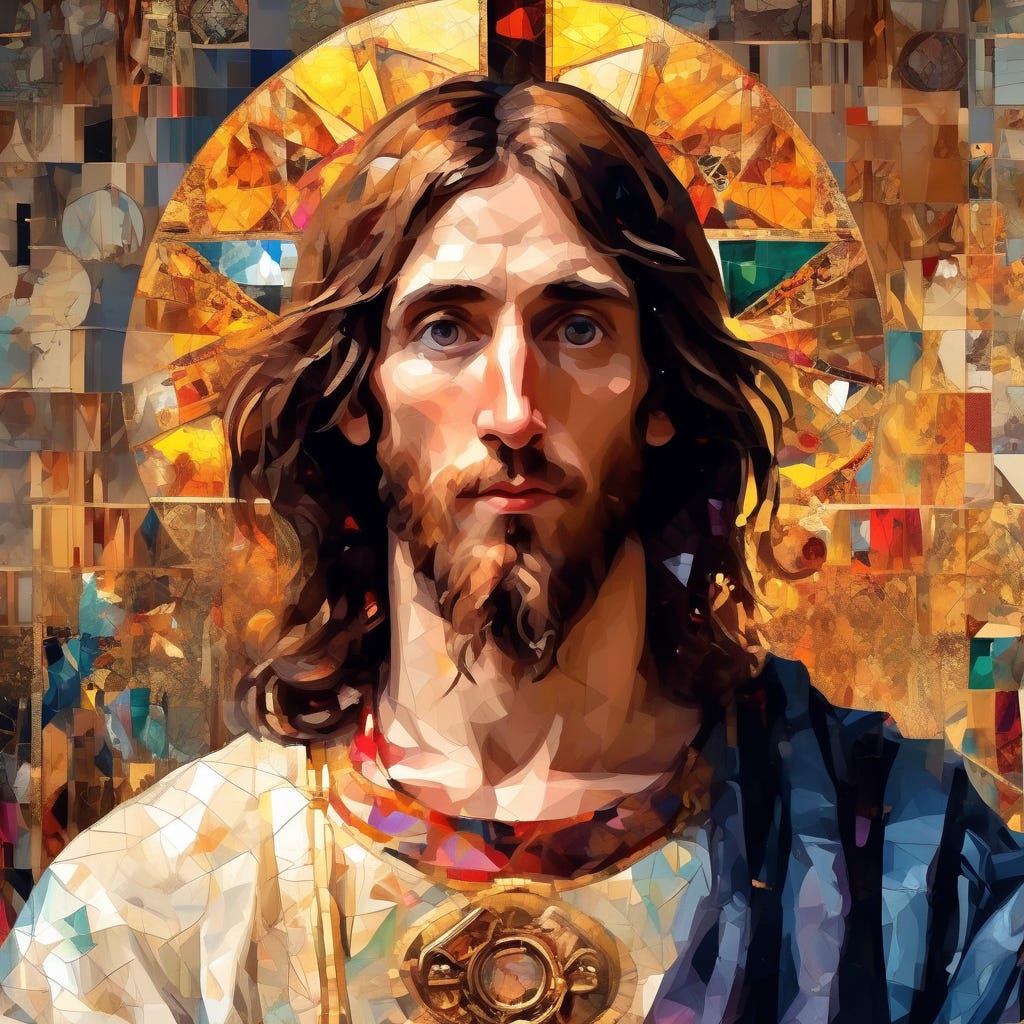Ziklag - The Church
Lutheran Ecclesiology in Babylon
Return to the Fellow Shape of Christ from Word and Table
The fragmentation of Lutheran ecclesiology is not merely doctrinal but linguistic. The Babel that exists between German Kirche and English Church—between the organic, sacramental reality of the Body of Christ and the institutional or individualistic distortions that often replace it—has led to a fundamental loss of clarity in what it means to be the Church. The Lord’s Supper, as both personal gift and corporate confession, stands at the heart of restoring this lost unity.
To recover a distinctly Lutheran ecclesiology, we must reclaim what it means to be in fellowship—not as a vague sentiment, but as the fellow shape of the Body of Christ, where Word and Sacrament define our communion.
Fellowship, Formation, and the Mission of the Church
I. Invitation to Prayer is Invitation to Fellowship
To pray together is to stand before God together. When Jesus teaches His disciples to pray, He does not say, “My Father,” but “Our Father” (Matthew 6:9). The Church does not pray as isolated individuals but as a single body speaking with one voice. Prayer is not just a personal act—it is a communal reality.
This reality is most evident in the Lord’s Supper. The words of institution are embedded within the great “Berakah”—the Eucharistic prayer of thanksgiving that connects Christian worship to Israel’s liturgical life. When Jesus prays over the bread and cup, He is not merely performing a ritual but drawing His disciples into the fellowship of His sacrificial work.
To invite someone to prayer is, in a very real sense, to invite them to communion. The Divine Service begins with the invocation of God’s Name—Jesus’ Name—“In the Name of the Father, and of the Son, and of the Holy Spirit”—which establishes the gathered assembly as the people of God. Prayer is not just preparation for worship; it is already an act of fellowship. To kneel together before God in supplication is to confess our shared dependence on His mercy.
II. Fellowship is Having Fellow Shape
Fellowship is not merely association but formation. The Greek word koinonia (Acts 2:42) does not refer to a casual gathering but to participation in the reality of Christ. The Lord’s Supper is not just a communal meal—it is a shaping act that forms the gathered people into the Body of Christ (1 Corinthians 10:17).
The Church takes on the shape of Christ Himself. It is not amorphous or self-defined but cruciform—formed by the pattern of its Head (Philippians 2:5-8). This shape is not determined by human will but by Word and Sacrament, which mold believers into the image of Christ (Romans 8:29).
To commune at the altar is to be shaped by Christ’s death and resurrection. The Eucharist is not a neutral event but an act of divine formation:
• It shapes the conscience (through absolution).
• It shapes the will (through faith’s reception).
• It shapes the body (by binding the believer into the ecclesial body).
III. Denying Fellow Shape is Self-Sabotage
To be in Christ is to be in His Body. No one receives Christ in isolation; faith is never a private possession detached from the Church. The idea of individual faith apart from ecclesial reality—“just me and Jesus” theology—is like a severed hand imagining itself whole.
Denying this reality leads to division and sectarianism. Luther did not seek to create a new sect but to preserve the one, holy, catholic, and apostolic Church. When doctrinal purity is divorced from sacramental fellowship, fragmentation is inevitable:
• Some err by collapsing the Church into rigid institutionalism.
• Others err by reducing the Church to loose spiritual affinity.
Lutheran theology resists both errors. The Church is neither a bureaucratic structure nor a vague spiritual sentiment—it is a real, sacramental, confessing body. Rejecting unity where unity exists is not an act of faithfulness but a denial of Christ’s work.
This applies both to:
• Radical sectarianism, which refuses to acknowledge fellow believers.
• False unionism, which seeks fellowship apart from shared confession.
If the Church is truly gathered around Word and Sacrament, it is self-sabotage to deny its reality.
IV. Inviting Others to Fellow Shape is the Mission of Christ
Jesus gathers—He does not call people into isolated spirituality but into one flock (John 10:16). The Supper is the culmination of this gathering, where believers are knit together in His body and blood. Evangelism is not merely about changing minds; it is about incorporating people into Christ’s body.
Baptism and the Lord’s Supper are not secondary to evangelism—they are evangelism in its highest form. Christ’s Great Commission (Matthew 28:19) is not simply about conversion—it is about bringing people into the full fellowship of Christ through Word and Sacrament.
The Church’s mission is not just to gather but to shape. True discipleship is not just about getting people to attend but forming them in the likeness of Christ. Word and Sacrament ministry is a continual reshaping of the people of God into the image of their Redeemer (Romans 6:3-5).
The Church does not merely invite people to hear about Jesus—it invites them to be conformed to His death and resurrection.
V. The Redemption of Lutheran Ecclesiology
The division between Kirche and Church, between doctrine and practice, between individual faith and communal faith, must be overcome. The Lord’s Supper is not an add-on to Christianity—it is its very center. The Church is not a voluntary gathering of like-minded people—it is the real presence of Christ’s body, shaped by Word and Sacrament.
To pray is to commune.
To commune is to be shaped.
To deny this shape is self-sabotage.
To invite others into this shape is the mission of Jesus Christ:
1. “He who has ears to hear, let him hear.” (Matthew 11:15)
Lutheran ecclesiology has been marred by a division between doctrine and life, between individual faith and the gathered body, between institutional rigidity and spiritual fragmentation. But Christ has not built a divided house (Mark 3:25). The Church, His Body, is not an abstraction, nor a mere sum of individuals. It is the mystery hidden for ages but now revealed (Colossians 1:26)—the singular people of God, gathered, fed, and sent. It is high time to heed again the voice of the Shepherd, to reclaim what was never lost but only misplaced, to let the Church be shaped not by the winds of men but by the breath of the Spirit.
2. Reclaim Prayer as First Step of Common Union
An Act of Gathered Unity
“Again I say to you, if two of you agree on earth about anything they ask, it will be done for them by my Father in heaven. For where two or three are gathered in my name, there am I among them.” (Matthew 18:19-20)
Prayer is not an individual act of piety; it is the speech of the Body of Christ. “Teach us to pray,” the disciples asked (Luke 11:1), and the Lord’s answer was not My Father but Our Father. The Church prays not as scattered voices but as one voice, for “there is one body and one Spirit—just as you were called to the one hope that belongs to your call.” (Ephesians 4:4)
The Psalms teach us to pray as a people, not as isolated souls:
• “O come, let us worship and bow down; let us kneel before the LORD our Maker! For He is our God, and we are the people of His pasture, and the sheep of His hand.” (Psalm 95:6-7)
• “I will give thanks to You in the great assembly; among the mighty people, I will praise You.” (Psalm 35:18)
The Fathers confirm this truth:
• “You cannot have God as your Father if you do not have the Church as your mother.” — Cyprian of Carthage
• “The prayer of one alone is not heard as easily as that of two; the Lord himself commands that our prayers be communal, uniting us in one heart and one voice.” — Tertullian
Thus, to pray together is to confess that we are one in Christ, one in Spirit, one in body. The Church does not pray as scattered individuals but as a gathered assembly. The world will not believe in the Christ we proclaim until it sees Him in the unity of our prayer (John 17:20-21).
3. Recover the Church’s Shape
Formed by Christ, Not by Individual Will or Institutional Legalism
“I am the vine; you are the branches. Whoever abides in me and I in him, he it is that bears much fruit, for apart from me you can do nothing.” (John 15:5)
The shape of the Church is not dictated by human hands, nor is it the product of bureaucratic order. It is the form of Christ, the cruciform pattern given by the Head to His Body. The Church is not an organization—it is an organism. It has a true form, a shape fashioned by the wounds of its Lord.
The Proverbs warn us against making our own shape apart from wisdom:
• “Do not move the ancient landmark that your fathers have set.” (Proverbs 22:28)
• “Many are the plans in the mind of a man, but it is the purpose of the LORD that will stand.” (Proverbs 19:21)
The early Church Fathers understood that the Church’s shape is given, not made:
• “The Church is the place of the Spirit, the dwelling of God among men, the pillar and ground of the truth.” — Irenaeus
• “He who does not have the Church for his mother does not have God for his father.” — Augustine
To recover the Church’s shape is to be conformed to Christ, not to the patterns of this world (Romans 12:2). It is to know that the Church is neither a hierarchy nor an anarchy but a body: joined, ordered, fed, and living.
4. Reject Self-Sabotage
Acknowledging Where True Unity Already Exists in Word and Sacrament
“If a house is divided against itself, that house cannot stand.” (Mark 3:25)
The greatest danger to the Church is not from without but from within—when it refuses to be what it is. Christ’s Body cannot war against itself without injury, yet too often, Lutherans refuse to acknowledge unity where unity already exists. The altar of Christ is not a weapon, and the pulpit is not a fortress.
Scripture condemns the folly of unnecessary division:
• “Whoever isolates himself seeks his own desire; he breaks out against all sound judgment.” (Proverbs 18:1)
• “Can two walk together, unless they have agreed?” (Amos 3:3)
The Fathers call for unity in the truth:
• “Do not let schisms enter among you; be subject to the bishop and to one another, as Christ was subject to the Father.” — Ignatius of Antioch
• “Where there is charity and love, God is there.” — Clement of Rome
To reject self-sabotage is to confess that the Church is not an idea, nor a human construct, but the real Body of Christ. If Christ is truly present in His Word and Sacrament, then we must not divide where He has united.
5. Renew the Mission
Not Just to Preach, but to Shape Through the Means Christ Has Given
“Go therefore and make disciples of all nations, baptizing them in the name of the Father and of the Son and of the Holy Spirit, teaching them to observe all that I have commanded you.” (Matthew 28:19-20)
The Church’s mission is not to talk about Christ but to give Christ—to shape people into His likeness through the Word preached, the Baptismal waters poured, and the Eucharistic feast given. Christ does not call us to create followers but to make disciples, to form people in His image (Galatians 4:19).
The Psalms proclaim the shaping power of God’s Word:
• “Your word is a lamp to my feet and a light to my path.” (Psalm 119:105)
• “He who dwells in the shelter of the Most High will abide in the shadow of the Almighty.” (Psalm 91:1)
The early Church knew that the mission of Christ is to shape, not just to inform:
• “No one is truly saved who has not been reshaped in the image of Christ.” — Basil of Caesarea
• “To be in Christ is not only to believe, but to live as He lived.” — John Chrysostom
This is not to teach justification by works but a Christian Life lived By Faith.
Trust in the power of God your Father, as the work of the Holy Spirit upon you, according to the Kingdom Kerygma of Jesus Christ, IS Christianity.
Item docent, quod homines non possint iustificari coram Deo propriis viribus, meritis aut operibus, sed iustificentur gratis propter Christum per fidem, cum credunt se in gratiam recipi et peccata remitti propter Christum, qui sua morte pro nostris peccatis satisfecit. Hanc fidem imputat Deus in iustitiam coram ipso, Rom. 3 et 4. Ferner wird gelehrt, daß wir Vergebung der Sünde und Gerechtigkeit vor Gott nicht erlangen können durch unser Verdienst, Werk und Genugtuung, sondern daß wir Vergebung der Sünde und Gerechtigkeit erlangen, umsonst und aus Gnade, durch Christus, durch den Glauben, wenn wir glauben, daß Christus für uns gelitten hat und daß uns um seinetwillen die Sünde vergeben und die Gerechtigkeit und das ewige Leben geschenkt wird. Denn diesen Glauben will Gott als Gerechtigkeit vor sich ansehen und zurechnen, wie Paulus sagt zu den Römern im dritten und vierten Kapitel. They also teach that men cannot be justified before God by their own strength, merits, or works, but are freely justified for Christ’s sake through faith, when they believe that they are received into grace and that their sins are forgiven for Christ’s sake, who by His death has made satisfaction for our sins. This faith God imputes for righteousness in His sight (Romans 3 and 4). the Augsburg Confession - Article 4
To renew the mission is to renew the shape of the Church—one formed by the Means of Grace, not by mere programs or philosophies. The world does not need more words about Jesus. It needs Jesus Himself, given in water, in Word, in bread and wine, shaping His people into His image.
The Redemption of Us
Lutheran ecclesiology will be restored when it once again confesses that the you singular and the you plural are one mystery—the Body of Christ, given for you.
We are:
1. One people in prayers of the Scriptures.
2. Shaped by Christ, in Christ, like Christ, for mankind, but not by men.
3. United wherever we choose to cease dividing.
4. We are the shape of the new world in Bible and Supper, no mere words alone.
The world may look with scornful wonder no matter what we do, but there is no reason for us to wallow in division, confusion, and bureaucracy when Christ Himself is present among us, calling, gathering and enlightening us, in and to Himself.
“That the world may know that You have sent Me, and loved them even as You have loved Me….” (John 17:23)
"As I Imitate Christ..." - St. Paul








God's peace